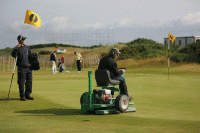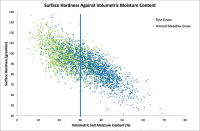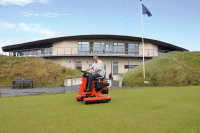Grass choice - a "firm" decision

Syngenta's 2013 survey, 'Growing Golf in the UK', found that the majority of golfers felt that a smooth ball roll was the most important 'on course' attribute. Indeed, fast greens did not even feature in the list. So, how do the golf greens in the UK and Ireland serve their customers? Data from the objective measurement of putting surfaces released by STRI, taken over the 2009-2013 period, gives us an indication of how well our grasses are meeting customer needs.
Objective measurement of grass performance for golf
Over that time, the organisation took 3,735 measurements from 1,866 greens (368 courses) across the UK and Ireland. 1,192 (64%) of these measurements were from parkland courses, 417 (22%) from links, 247 (13%) heathland and 10 (1%) other. This is a decent database, with the majority of the data collected from parkland courses, an important point to bear in mind when analysing the information.

The conclusions were that the fine grass greens were consistently smoother, truer and faster than annual meadow-grass greens, and that the fine grass greens were not as prone to seasonal inconsistency for these measured parameters. This is not overly surprising, given the well-known issues facing managers of annual meadow-grass surfaces, including seed head production, disease susceptibility and fragility under conditions of drought and cold-stress.
So, if we want to give golfers consistent surfaces year-round, then we should favour the fine grass. However, the measurements that I feel are the most interesting, and which contribute immensely to consistent year-round performance, are those for surface hardness and volumetric soil moisture content (VSMC), which are shown on the accompanying graph. These are the data sets that I will focus on for the remainder of this article.

The most obvious statement from the data represented in the graph is that fine grass is favoured by harder and drier conditions, annual meadow-grass by softer, wetter ground. As with all relationships, it is not as simple as this, with both types of turf appearing in each other's dominant territory. This may well be down to site conditions, with annual meadow-grass tolerating harder, drier situations such as links or USGA Recommendation greens. Fine grass may simply be tolerant of a wide spectrum of surfaces, though the proportion of annual meadow-grass to the softer, wetter fine grass dominated greens may be relatively high - though not 50% or more!
When considering which grasses your course should favour, don't simply make a decision based on green or blue dots on a graph. Neither should we confine our ambition to the belief that fescue/bent is for links and annual meadow-grass is for parkland. Target ranges for hardness are 100-150 Gravities for links and 85-110 for parkland greens. The ranges for soil moisture content are 10-25% for links and 15-30% for parkland. Another look at the graph shows that there are a lot of fine grass greens within the parkland target ranges. The inference is that you can have playable parkland greens with fine grass, and that you do not need to aim for unrealistic levels of hardness to achieve fine grass greens.
There are a number of caveats when considering the type of green and grass your course is capable of supporting and, amongst them, is design. Parkland courses not designed for the running game should not implement the STRI's target range for links, perhaps not even the higher end of the range for parkland. Shade will also affect which grasses you can grow - with a browntop bent dominant sward (only requiring 50% or over, remember) possibly being as good as it can get. The key to producing consistency will be to achieve a true blend of grasses.

The data on hardness and volumetric soil moisture content does raise a number of questions, which include:
- Are the annual meadow-grass greens to the left of the graph (say >90 Gravities and <25% VSMC) prime for conversion to bent/fescue, with the possibility of limited disruption to the quality of playing surface through the process?
- What level of resources is required to produce annual meadow-grass greens above 100 Gravities? I would suggest that these are out of their natural comfort zone and require the full tool kit available to greenkeepers, including plant growth regulators, enough fertiliser and water to minimise stress, fungicides, lots of sand topdressing, etc. However, they could also, sadly, be poorly managed links/heathland greens; a clear opportunity for conversion to bent/fescue.
- What might happen to such greens when the greenkeeper loses the spanner or hammer from their tool kit?
- What sort of surfaces are greenkeepers presenting at VSMCs over 30%? The USGA "Recommendations for a Method of Putting Green Construction" specify that the rootzone should have a total porosity of 35-55%, which they define as "the degree to which the soil mass is permeated with pores or cavities". If water is filling much of this space, as it has to be to a number of greens on the graph, then the soils are approaching saturation point. Were all of the values close to this mark recorded after heavy rain, or could they be indicative of over-watering and a management strategy aimed at preserving annual meadow-grass, which will compromise year-round playability?

- What is the influence of the amount and the nature of organic matter on the hardness/soil moisture content relationship? Could the physical and structural differences between the fibre associated with bent/fescue turf and the more water retentive thatch associated with annual meadow-grass be significant? Could the proportion of fibre to thatch influence species composition and the opportunity to bring about a successful and relatively painless conversion? Are the annual meadow-grass surfaces at the higher end of the hardness and lower end of the soil moisture ranges almost devoid of thatch and, hence, being managed on a knife edge?
- In essence, can such data be used as a diagnostic for healthy greens and grasses most appropriate to individual circumstances? Can it be used to indicate the potential for greens to support fine grass?

More data, please! Only by collecting this sort of information and analysing it critically will we gain a better understanding of how turf management really impacts on playing performance. This is the sort of information that, if handled properly, can provide real practical guidance to greenkeepers which will benefit their profession, the surfaces they prepare and the clients they serve.
This, however, is only part of the story. Yes, golfers want great playing surfaces, but they also want them at an affordable price. Great golf surfaces must not come at the cost of damage to the environment or at the expense of golf's environmental reputation, or in a way that antagonises and alienates local communities. One important next step might be to undertake economic and environmental impact assessments, along with playing performance, at sites with optimal fine grass and annual meadow-grass surfaces. We await a proposal!
